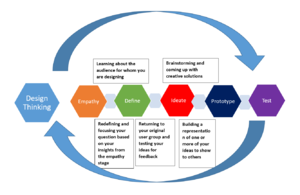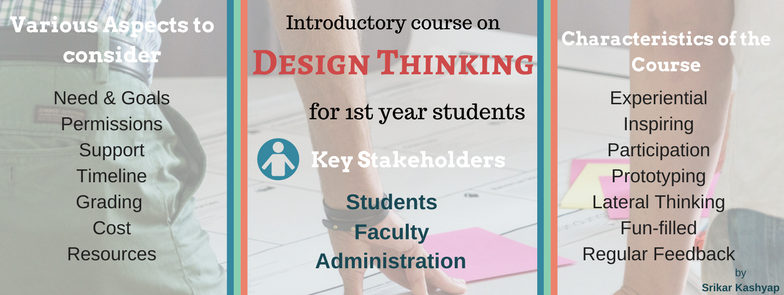Resource:How to create a design thinking class for incoming first-year students
Contents
Need
The need identified in this “How To” is to create a design thinking class for the incoming first year students. A popular topic in the UIF exploration of higher education is the incorporation of design thinking; which when incorporated into curriculum is highly beneficial.
Through this article we discuss how one might implement an introductory course for first year students with advice from current fellow, Jason Weis. Jason is a fourth year student studying Biomedical Engineering (BME) at Georgia Tech (GT). At Georgia Tech, Weis has been involved with many mentorship programs, including being a co-founder of the campus wide KNIT Mentorship and a leader of the BME Mentorship Program.
Since becoming a UIF in March of 2017, Jason and the GT Leadership Circle have designed and implemented a class that integrates design thinking and Biomedical Engineering.
Objectives and Goals
The purpose behind the course is to lay a framework of design thinking skills that students will use later in their college careers while simultaneously learning about their major. Design thinking helps make introductory courses more experiential and engaging. This occurs through a series of brainstorming workshops and creative projects that develop ideation and problem solving skills.
Why Design thinking?
A design thinking background helps students explore their majors in a deeper way. It is a style of learning made famous through Stanford’s Hasso Plattner Institute of Design as a successful strategy for innovation. Design thinking enables students to explore their ideas and dive deep into their meanings.
Academic Permissions
Academic permission may be required to integrate design thinking into a introductory course. In some cases, permission comes from faculty support and committee acceptance. In other cases, it may require a more stringent administrative review. In the past, oppositions have been persuaded after one-day “pop up classes” have gained student interest. This can be a way to show to the administrative staff and faculty that these forms of experiential classes are needed to promote positive growth within the university.
Support
Academic support is one of the hardest, but most important steps in creating change. There are three major groups to interact with that will enable the support for creating a design thinking course:
1. Students
Getting a large audience on board is an important step. It is the responsibility of the organizers to make sure to evoke interest in students through interactive exercises and fun-filled activities. Word of mouth plays a critical role in these endeavours, so make sure students leave the class with fervor for design thinking and inspire more students to join the class.
2. Faculty
Faculty support is crucial to creating change in the curriculum. Whether the course is taught by fellows or by faculty, both parties must be in communication so to revise the course and continuously prepare students for the major studies. Working with these professors will eventually lead us to the right people and help create change.
3. Administrators
Administration can be difficult to receive support from. Faculty support and student interests are powerful rhetorics in this instance. Receiving financial support from the school is also crucial to providing classroom resources and materials. In previous years, resources for a design thinking course have been conservative and have included low-cost rapid prototyping materials of the likes of post-its, paper, tape, and scissors.
Faculty
The faculty or fellows are the instructors who act as facilitators for design thinking, some of their duties include:
- Teaching the students what design thinking is
- Guiding the students through their designs
- Mentoring students throughout their projects
- Inspiring students imagination and creativity
Students
Students who do well in the course could potentially be trained to teach the following year; however, as of now only University Innovation Fellows have been trained to facilitate the course. Georgia Tech Innovation Fellows like Jason Weis are teaching the first iteration of the course specifically for first year Biomedical Engineering students. Students are inspired by the UIF team and their creative lens. Through this design thinking class they are able to show amazing results in the form of prototypes, presentations, and many more.
Timeline
The course can be developed as a full semester credit/uncredited course or it could be expressed as a course of a shorter length. This entirely depends on the time available and student interest. Make sure that the course is a blend of short theoretical lectures and practical hands-on sessions. Start slow and gradually increase the pace of the course as students get a hold of the subject.
Class Structure
The class structure can expand to topics of one introductory course for all majors to help first year students decide a major based on their interests in this design thinking class.
Grading System
Depending on whether it would be a credited or uncredited course, adjustments to the grading system can be made. While grades do play a key role in the academic setting, make sure that students do not get obsessed with the grading of this course. Participation must be rewarded by having a certain weightage in the grade. Some of the recommended grading points can be:
- Attendance
- Classroom participation
- Pitchs
- Group Discussions
- Prototype modelling
Cost
To create this program there is not much funding needed. The main costs come from the prototyping materials needed throughout the class such as post it notes and paper. This class has minimal cost to the school and the students are expected to buy the “Design Your Life” textbook needed for this class.
Recommended Resources & Learning Materials
Designing Your Life: Build a Life that Works for You - William Burnett, Dave Evans (Amazon US, Amazon India)
Summary
Contributors
| Bhavyatha Pandrangi | Jaran Arroyo | Lexy Foor |
| Sally Todd | Savanna Turner | Shruthi co |
| Srikar Kashyap Pulipaka |



